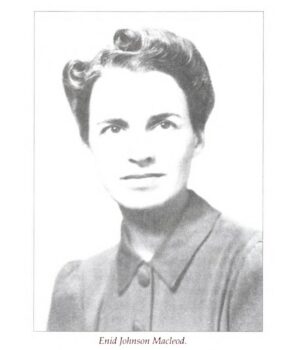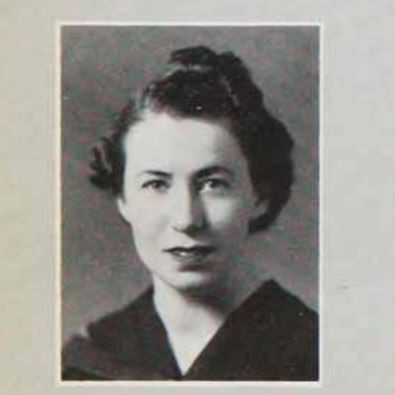Two McGill female anaesthetists were instrumental in advancing this new field in the 1940s. They went on to be anaesthesia leaders in Canada and the US, advocating for their patients – and for women in medicine
In the 1940s, Montreal physicians were leaders in the development of the new specialized field of anaesthesia, specifically the well-known trio Dr. Harold Griffith, Dr. Wesley Bourne and Dr. Digby Leigh (the latter in paediatrics). What is less well known is that Dr. Griffith and Dr. Leigh were assisted in these advances by their younger female colleagues, Dr. Enid Johnson and Dr. Kay Belton respectively, who were pioneers in the field, and in the profession in general.

Dr. Enid Johnson
Dr. Enid Johnson came to Montreal to undertake her residency after completing her medical training at Dalhousie University in 1937 where she had been the only woman in her class. “I was just like a queen – they waited on me hand and foot,” the Nova Scotia native recounted in an interview used in a video created for her posthumous induction into the Nova Scotia Science Hall of Fame in 2010 (below). So it came as a shock to her when she had a hard time finding a residency program that would accept her – because she was a woman.
“I answered all the advertisements in the medical journals where they asked for residents or interns and only one hospital answered me,” she said. That hospital was the Montreal Homeopathic Hospital (later the Queen Elizabeth Hospital). Even they were somewhat reluctant, but decided to take a chance on her as they had no better prospects. For Dr. Johnson, who had no thoughts of specializing in anaesthesia before, it would become a life-changing decision, as well as an historic one for the field.
Arriving at the Montreal Homeopathic Hospital in 1939, Dr. Johnson worked under the anaesthetist Dr. Harold Griffith, who ran the hospital and later became Chair of McGill’s Department of Anaesthesia (established in 1945).
Dr. Griffith was always at the vanguard in terms of adopting new technologies. He had been one of the earliest adopters in Canada of intratracheal anaesthesia (administering anaesthesia via a catheter inserted in the trachea rather than via a mask) and of the anaesthetic ethylene. He was the first in Canada to employ the anaesthetic gas cyclopropane in 1933. By the time Dr. Johnson arrived, he was routinely using endotracheal cyclopropane – which not commonly used because it was highly flammable and required a high level of skill – when ether was still the first line anaesthetic and was still administered via a mask. He had set up an anaesthetic induction room, the first Dr. Johnson had ever seen, next to the OR where patients could be put to sleep in a quiet setting away from the preoperative clatter.
Dr. Johnson learned all these cutting-edge techniques from Dr. Griffith and helped him develop new ones. In 1942, the pair tried a new technique that would revolutionize both anaesthesia and surgery: the introduction of the muscle relaxant curare.
Curare is derived from a vine native to South America and was traditionally used by Indigenous hunters as a blow dart poison to knock out the animals they were hunting. It was used successfully in medicine by a small number of US psychiatrists in patients undergoing shock therapy. Dr. Griffith heard about this and thought it would be worth trying in general surgery. During a routine appendectomy, Dr. Johnson became the first anaesthetist to administer curare during surgery. The operation was a success and Drs. Griffith and Johnson began using curare regularly at the Homeopathic Hospital.
They also spread the news to their colleagues: “Every anesthetist has wished at times that he might be able to produce rapid and complete muscular relaxation in resistant patients under general anesthesia. This is a preliminary report on the clinical use of a drug which will give this kind of relaxation, temporarily and apparently quite harmlessly,” they wrote in their paper on that first try published in July 1942, just six months later.
It is difficult today to understand the significance of this seemingly small innovation, but in the field everyone now recognizes that it revolutionized anaesthesia, surgery and by extension medicine itself.
“Many anesthesiologists regard the introduction of curare as being among the most important advances in anesthesia since the discovery of ether’s action in 1846. Anesthesiologists who practised before muscle relaxants came into use recall the terror they felt when a premature attempt to intubate the trachea under cyclopropane caused persisting laryngospasm. Before 1942, abdominal relaxation was possible only if the patient tolerated high concentrations of an inhaled anesthetic, which might bring profound respiratory depression and protracted recovery. Curare and the drugs that followed transformed anesthesia profoundly. Before this time, tracheal anesthesia was an art reserved for the expert; now it became a skill that all anesthesiologists could acquire.”*
However revolutionary it was, the use of curare didn’t catch on overnight and even Dr. Johnson couldn’t convince some of her colleagues to try it. After finishing her residency, she returned to her native Nova Scotia and began practising as an anaesthetist in Sydney on Cape Breton Island. Dr. Johnson recounts how she was banned from using curare there. “They had never had a specialist in anaesthesia before…. It was usually chloroform and ether, I was one of the first persons to use cyclopropane exclusively, but I was never allowed to give curare – that was “arrow poison” and much too dangerous for their patients!”**
Dr. Johnson later moved to Dartmouth and took a position as a faculty member of the Dalhousie Medical School’s Department of Physiology and Biophysics, retiring 16 years later as Associate Professor of Physiology.
She was an active member of the Federation of Medical Women in Canada (FMWC) and was its president in 1969-70. The Enid Johnson MacLeod Award was established to recognize a FMWC member involved in the promotion of women’s health research and/or women’s health education. In 1990, Dr. Johnson wrote Petticoat Doctors: The First Forty Years of Women in Medicine at Dalhousie University (Potters field Press, 1990).
Enid Johnson MacLeod died in Ottawa in 2001 at the age of 91.
Dr. Kay Belton

Dr. Mabel Kathleen “Kay” Belton was one of a group of influential anaesthetists working to improve anaesthesia care for children in an era when the field was very young and most energy was being put into adult care. Like Enid Johnson, Dr. Belton was doubly remarkable: as an innovator in developing the new field of anaesthesia and as a woman working in a medical discipline that was, like most at the time, dominated by men.
Dr. Belton was originally from Saskatchewan and began her medical degree there, switching to McGill in 1938 to complete her training, graduating in 1941. She then did a residency in pathology at the Montreal General Hospital before specializing in anaesthesia, doing postgraduate training at the Toronto and Montreal General Hospitals and the Children’s Memorial Hospital (CMH, now the Montreal Children’s Hospital). After receiving her Royal College certification in 1946, she was immediately appointed Assistant Director of Anaesthesia at the CMH in 1946, under Director Dr. Digby Leigh, later known as the “father of paediatric anaesthesia in Canada,” as well as to the medical faculty at McGill.
Dr. Belton was Dr. Leigh’s close collaborator in a variety of developments in paediatric anaesthesia at the CMH, including advancing the use of intubation in this population, which was made possible by the creation by Dr. Leigh and others of specialized breathing tubes and valves for children, and importantly, developing training programs and training future paediatric anaesthetists.
In 1947, Drs. Belton and Leigh were recruited by the Vancouver General Hospital, where Dr. Belton was named anaesthetist in charge of paediatrics. The pair immediately set about modernising paediatric anaesthesia practices in Vancouver, putting in place many of the innovations developed at McGill, aided by the presence of a large number of their McGill trainees who followed them. A year later, Drs. Leigh and Belton published their influential text, Paediatric Anaesthesia, the first guide of its kind published in North America. “They championed the use of tracheal intubation and the value of muscle relaxants, provided a detailed description of cut-down for saphenous vein cannulation, and described regional anesthesia, including 13 different nerve blocks, caudal, and spinal anesthesia.” ***
In 1954, the pair moved again, this time to California, where Dr. Belton became Assistant Director of the Los Angeles Children’s Hospital (Dr. Leigh was Director) and Clinical Assistant Professor of Anesthesia at the University of Southern California Medical School. She switched to private practice in 1960 and later became the first female president of the California Society of Anaesthesiologists in 1967. Advancing the field of paediatric anaesthesia and training anaesthetists remained a lifelong priority. In the early 1970s, Dr. Belton put her practice on hold and took part in medical missions in Tunisia and in a plastic and reconstructive surgery centre in Saigon during the Vietnam War.
Kay Belton died in California in 1980 at age 64.
Notes:
*Clinical Anesthesia 4th edition, Ed. Paul G. Barash, Bruce F. Cullen, Robert K. Stoelting (Lippincott Williams & Wilkins Publishers, 2001)
** Harold Griffith: the evolution of modern anaesthesia, Richard Bodman, Deirdre Gillies (Hannah Institute, 1992)
*** “A history of pediatric anesthesia: a tale of pioneers and equipment.” Christine L. Mai and Charles J. Coté Pediatric Anesthesia (Vol 22, 2012)
March 11, 2021

